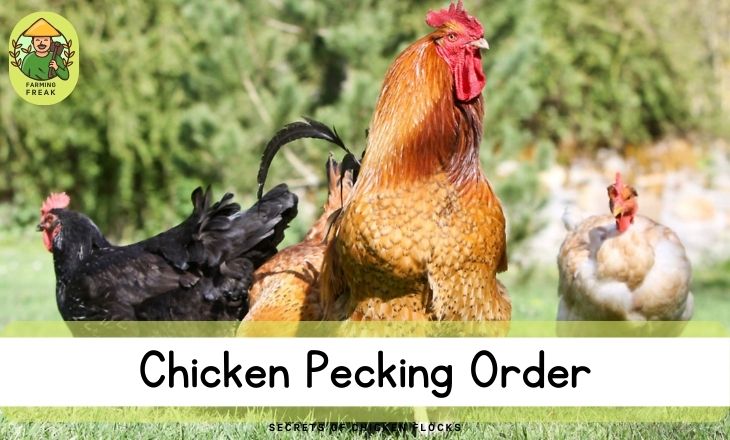Pecking order is essential for keeping within the flock to ensure the well-being and contentment of chickens. Chickens have developed their social structure to maintain order within their groups.
The pecking order, where each chicken has a rank in the hierarchy, gives the order to their combination and behaviour. It has been an effective way for chickens to establish leadership and minimise conflict within the group over time.
The “ Chicken Pecking Order ”, within a chicken flock is not just an amusing phrase, it is a fascinating phenomenon that sheds light on the dynamics of animal behaviour and social structure.
What is a Pecking Order?
The pecking order meaning in a chicken flock is fixed by a complex social hierarchy, where the dominant establish their status through aggressive behaviour such as pecking. This behaviour is driven by aptitude and serves to maintain order within the flock.
Aggression and pecking are part of the natural dynamic of a chicken flock. Excessive strength can be harmful to the all-inclusive health of the birds.
Chicken Pecking Order:
The pecking order of chickens, also known as the protective hierarchy, is a way for chickens to establish and maintain communal order within their flock. This hierarchy helps to reduce aggression and conflict by establishing a clear ranking system.
It is all about who gets the first claim on food, water, and the best spots for chilling out. If they have grown up together, they sort it out pretty quickly and live in peace most of the time.
What Does Pecking Order Theory Say?
The pecking order theory of chicken refers to the social hierarchy within a group of chickens. It’s often used as an analogy for human social structures. Pecking order consists of different rules and you can check them from the chicken pecking order chart.
By not following these rules you can face various chicken pecking order problems. In a chicken flock, there is a clear ranking system where each chicken knows its place in the group. The top-ranking chicken has the most privileges and can access food and resources first while lower-ranking chickens have to wait their turn.
This theory suggests that social groups, including humans, tend to organize themselves similarly, with individuals establishing dominance and subordination within the group.
The Role Of The Top Chicken In The Flock:
The top chicken in a flock, also known as the alpha or dominant hen, plays a crucial role in maintaining order and hierarchy within the group. The capon chickens are known for their large size, making them an ideal choice for special occasions or when feeding a crowd.
Guardian And Protector
The top chicken in a flock plays a crucial role in keeping an eye out for potential threats. Their keen sense of awareness helps them detect predators like hawks and other dangers, prompting them to alert the rest of the flock and guide them to safety.

This instinct is essential for the survival of the group, as it allows the chickens to stay safe and avoid potential harm.
Expert Forager
They have a keen eye for spotting tasty grubs under fallen logs or kitchen scraps. They have the right to eat first, but they usually allow the other chickens to feed before eating. This behavior is a way of maintaining order within the flock and ensuring that everyone gets their fair share of food.
How To Stop Pecking Order In Chickens?
You can stop chickens from pecking each other in several ways:
Perfect Ratio Of Roosters To Hen
It is consistently recommended to have one rooster for every 10 to 12 hens. Flocks with fewer than six hens should not have a rooster at all, as it can negatively impact the hens’ health.

Maintaining a good ratio helps prevent excessive fighting among roosters, who are more aggressive about establishing their social status. Many chicken farmers have noticed that chicken society is naturally organised into groups of 10 or 12 hens, each led by a dominant rooster.
Space Needs
Chicken owners can promote peace in their flock by providing enough space.
When chickens are crowded, they tend to be more aggressive in establishing their social order. It is also proposed to have at least four square feet of space per bird in the coop and 8 square feet outside in the chicken run. If there are roosters, it’s best to double the recommended space.
Birdcage Setup
The layout of the coop is important, too. To reduce stress, place feeders and waterers in the centre of an open space rather than in a corner, allowing plenty of room for the birds to move around.
Each chicken should have at least three inches of feeder and water space, so if you have more than six birds. It is finest to use multiple feeders and waterers with plenty of space between them. It is also best possible to have one set inside the coop and one outside.
You also have to make sure there is at least one nesting box for every four hens and 8 inches of roosting bar per bird to minimise fighting.
When Do Chickens Pecking Fight With Each Other?
When a new chicken or group of chickens join an established flock, it can lead to violent clashes as the pecking order gets disrupted and needs to be sorted out again. If the newcomers are younger or outnumbered, the situation can turn deadly.

Capon chickens play a unique role in chicken flocks. For a premium selection of capon chicken, consider checking out specialty butcher shops and high-end grocery stores in your area. Since they have been neutered before reaching sexual maturity, capons do not exhibit aggressive behaviour typically seen in unneutered roosters. This makes them more docile and easier to handle, reducing the risk of fights and injuries within the flock.
Chickens have a horrible tendency to attack any bird that is bleeding, pecking at the wound. If the injured chicken isn’t separated from the others, it could be pecked to death and then eaten by the rest of the flock.
Conclusion:
The main principle to understand the “ Chicken Pecking Order ” in chicken flocks to keep things running smoothly. Poultry keepers can better manage their flocks and reduce the occurrence of aggression and stress by admitting the dynamics of dominance and submission.
The pecking order can help identify potential issues, such as bullying or overcrowding, that may affect the well-being of the birds. Implementing strategies to support a healthy pecking order, such as providing ample space, enrichment, and appropriate nutrition, is essential for ensuring a balanced and contented flock.
FAQ’s:
How Long Does It Take For Chickens To Sort Out Pecking Order?
The time it takes for chickens to establish a pecking order can differ depending on the size of the flock and the individual personalities of the birds. It can take anywhere from a few days to a few weeks for chickens to sort out their pecking order. There may be some squabbling and aggression during this time as the birds establish their social hierarchy.
What Is Pecking Order?
The pecking order is a crucial aspect of social organisation within bird groups, dictating the hierarchy and status of each independent. It determines the ranking and dominance of individuals within the group based on factors such as age, size, strength, and aggression.
What Is Normal Pecking Order Behavior?
It refers to the natural social hierarchy that exists within a group of animals, particularly birds and poultry. It is characterised by dominant individuals asserting their authority over junior members through pecking, chasing, or other displays of dominance.
What Is Chicken Pecking Order By Breed?
This order can vary by breed, with some breeds being more assertive and dominant than others. For example, Rhode Island Reds and Plymouth Rocks are known for being more dominant, while Silkies and Polish chickens tend to be more submissive.
- Chicken Pecking Order: Top Secrets Of Chicken Flocks (2024) - May 26, 2024
- Top 5 Differences Between Rabbits and Hares - May 25, 2024
- 9 Edible Weeds Likely Growing in Your Yard (2024) - May 23, 2024

